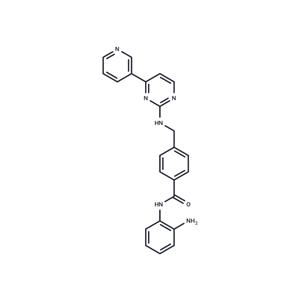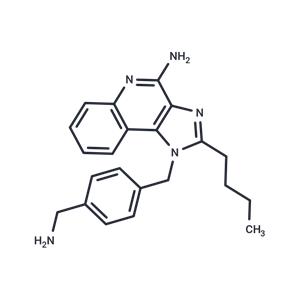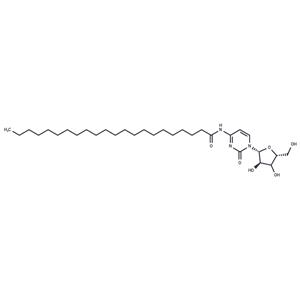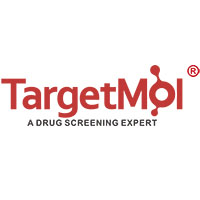
Mocetinostat NEW
| Price | $36 | $52 | $80 |
| Package | 5mg | 10mg | 25mg |
| Min. Order: | |
| Supply Ability: | 10g |
| Update Time: | 2024-11-19 |
Product Details
| Product Name: Mocetinostat | CAS No.: 726169-73-9 |
| Purity: 99.37% | Supply Ability: 10g |
| Release date: 2024/11/19 |
Product Introduction
Bioactivity
| Name | Mocetinostat |
| Description | Mocetinostat (MG0103) is an orally available HDAC inhibitor with most potency for HDAC1 (IC50: 0.15 μM), 2- to 10- fold selectivity against HDAC2/3/11. |
| Cell Research | Cells were transfected with antisense oligonucleotides for 4 h everyday for 2 d. At 48 h after initial transfection, cells were harvested and apoptosis was evaluated with the Cell Death Detection ELISA Plus kit following the manufacturer's protocol. In all experiments, a fixed amount of DNA-histone complex, provided with the ELISA kit as a positive control, was used to ensure results were comparable among experiments. To analyze caspase-dependent apoptosis, an antibody specifically recognizing the caspase cleavage fragment of human poly(ADP-ribose) polymerase (PARP) was used to probe Western blots of lysates from cells treated with MGCD0103 [1]. |
| Kinase Assay | The deacetylase enzyme assay was based on a homogeneous fluorescence release assay. Purified recombinant HDAC enzymes were incubated with compounds diluted in various concentrations for 10 min in assay buffer [25 mmol/L HEPES (pH 8.0), 137 mmol/L NaCl, 1 mmol/L MgCl2, 2.7 mmol/L KCl] at room temperature. The substrate Boc-Lys(ε-Ac)-AMC was added to the reaction for further incubation at 37°C. The concentration of the substrate and the incubation time varied for different isotypes of HDAC enzymes. A 20-min trypsin incubation at room temperature allowed the release of the fluorophore from the deacetylated substrate. The fluorescent signal was detected by fluorometer at excitation of 360 nm, emission of 470 nm, and cutoff at 435 nm. The IC50 values of the compounds were determined by analyzing dose-response inhibition curves [1]. |
| Animal Research | Female CD-1 nude mice, ages 8 to 10 wk, were used. Tumor fragments (~30 mg), which had been serially passaged thrice in vivo in minimal, were implanted s.c. through a small surgical incision on the flank of the mice while under general anesthesia. HDAC inhibitors were dissolved in vehicle (PBS acidified with 0.1 N HCl or PEG400/0.2 N HCl saline, 40:60) and dosed p.o. as solutions daily. Tumor volumes and body weight were monitored thrice weekly for at least 2 wk. Each experimental group contained six to eight animals. For pharmacokinetic study, blood was collected from animals at various time points, and plasma samples were analyzed using an HPLC system coupled with a triple quadrupole mass spectrometer [1]. . Forty rats (220 ± 20?g) were randomly divided into four different dosages of MGCD0103 groups (Low group, Medium group, High group, and control group with 10 rats in each group). MGCD0103 was dissolved in corn oil as suspension at three different concentrations (20, 40, and 80?mg/mL). Three different MGCD0103 groups (Low group, Medium group, and High group) were respectively given MGCD0103 20, 40, and 80?mg/kg one time by intragastric administration at every morning and last for 7 days. Control group were given saline by same administration method. At 8 days morning, six probe drugs, bupropion, phenacetin, tolbutamide, metoprolol, testosterone, and omeprazole, were mixed in corn oil and given to the rats of three MGCD0103 groups and control group by intragastric administration at a single dosage of 10?mg/kg for bupropion, phenacetin, metoprolol, testosterone, and omeprazole and 1?mg/kg for tolbutamide. Blood (0.3?mL) samples were collected into heparinized 1.5?mL polythene tubes from the tail vein at 0.0833, 0.5, 1, 2, 3, 4, 6, 8, 12, 24, and 48?h after intragastric administration of six probe drugs. 100?μL of plasma was obtained from blood sample after centrifugation at 4000?g for 10?min. In a 1.5?mL centrifuge tube, 200?μL of acetonitrile (containing 50?ng/mL IS) was added into 100?μL of collected plasma sample. After vortex-mixing for 1.0?min, the sample was centrifuged at 13000?g for 15?min. Then supernatant (2?μL) was injected into the UPLC-MS/MS system for analysis. Concentration of plasma probe drugs versus time was analyzed by Version 3.0 Data Analysis System. The main pharmacokinetic parameters of the MGCD0103 group and control group were analyzed by SPSS l8.0 statistical software [3]. |
| In vitro | Mocetinostat (MGCD0103) potently targets human HDAC1 but also has inhibitory activity against HDAC2, HDAC3, and HDAC11 in vitro. In intact cells, MGCD0103 inhibited only a fraction of the total HDAC activity and showed long-lasting inhibitory activity even upon drug removal. MGCD0103 induced hyperacetylation of histones, selectively induced apoptosis, and caused cell cycle blockade in various human cancer cell lines in a dose-dependent manner [1]. MGCD0103 inhibited HDAC activity in several human cancer cell lines in vitro and in human peripheral WBC ex vivo in a dose-dependent manner. The HDAC inhibitory activity of MGCD0103 was time-dependent and sustained for at least 24 hours following drug removal in peripheral WBC ex vivo [2]. |
| In vivo | In vivo, MGCD0103 significantly inhibited the growth of human tumor xenografts in nude mice in a dose-dependent manner and the antitumor activity correlated with the induction of histone acetylation in tumors [1]. Inhibitory activity of MGCD0103 was sustained for at least 8 hours in vivo in mice and 48 hours in patients with solid tumors. In cancer patients, sustained pharmacodynamic effect of MGCD0103 was visualized only by dose-dependent enzyme inhibition in peripheral WBC but not by histone acetylation analysis [2]. The 7-day intragastric administration of MGCD0103 with high dosage slightly induces the metabolism of tolbutamide in rat. MGCD0103 was not able to induce or inhibit the activity of CYP1A2, CYP2B1, CYP2D4, and CYP3A2 enzyme [3]. MGCD0103 improved pulmonary artery acceleration time and reduced systolic notching of the pulmonary artery flow envelope [4]. |
| Storage | Powder: -20°C for 3 years | In solvent: -80°C for 1 year | Shipping with blue ice. |
| Solubility Information | DMSO : 11 mg/mL (27.7 mM) H2O : < 1 mg/mL (insoluble or slightly soluble) Ethanol : < 1 mg/mL (insoluble or slightly soluble) |
| Keywords | HDAC | Histone deacetylases | Mocetinostat | Autophagy | Apoptosis | inhibit | MGCD 0103 | MGCD-0103 | MG-0103 | MG 0103 | Inhibitor |
| Inhibitors Related | Stavudine | 5-Fluorouracil | Sodium 4-phenylbutyrate | L-Ascorbic acid | Hydroxychloroquine | Guanidine hydrochloride | Taurine | Tributyrin | Curcumin | Paeonol | Naringin | Gefitinib |
| Related Compound Libraries | Bioactive Compound Library | Approved Drug Library | Anti-Cancer Clinical Compound Library | Drug Repurposing Compound Library | Inhibitor Library | Anti-Cancer Approved Drug Library | Anti-Aging Compound Library | Bioactive Compounds Library Max | Anti-Cancer Active Compound Library | Anti-Cancer Drug Library |
Company Profile Introduction
Target Molecule Corp. (TargetMol) is a global high-tech enterprise, headquartered in Boston, MA, specializing in chemical and biological research product and service to meet the research needs of global customers.
TargetMol has evolved into one of the biggest global compound library and small molecule suppliers and a customer based on 40+ countries. TargetMol offers over 80 types of compound libraries and a wide range of high-quality research chemicals including inhibitors, activator, natural compounds, peptides, inhibitory antibodies, and novel life-science kits, for laboratory and scientific use. Besides, virtual screening service is also available for customers who would like to conduct the computer-aided drug discovery.
You may like
Recommended supplier
| Product name | Price | Suppliers | Update time | |
|---|---|---|---|---|
| $1.00/1KG |
VIP7Y
|
Career Henan Chemical Co
|
2018-08-21 |
- Since: 2011-01-07
- Address: 36?Washington?Street, Wellesley?Hills
INQUIRY







 United States
United States